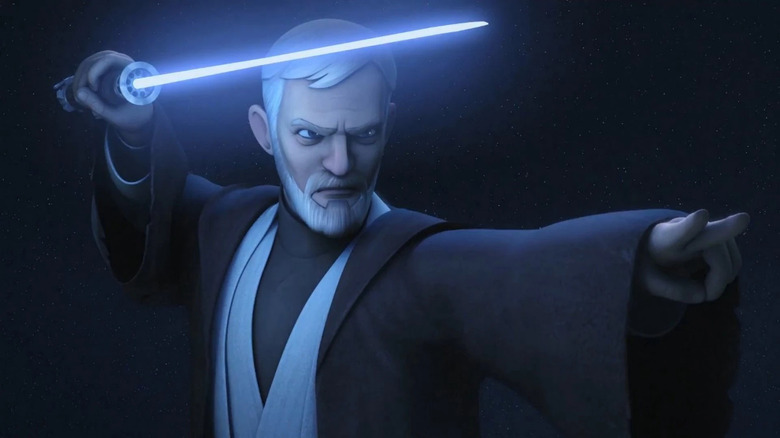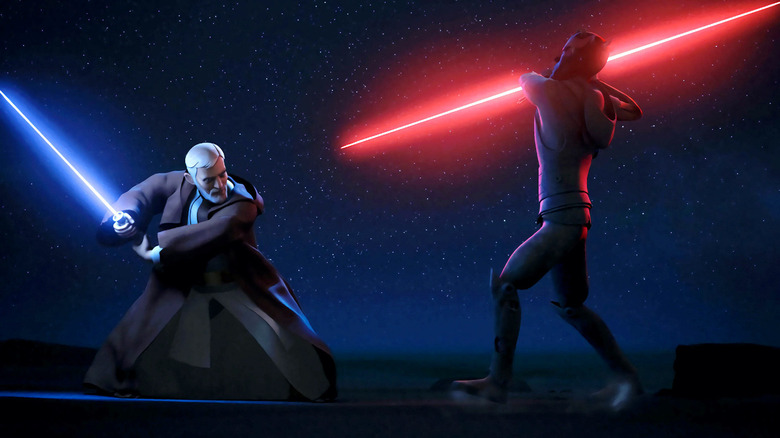Obi-Wan's Fighting Style In Rebels Is A Thoughtful, Evolutionary Star Wars Easter Egg
What makes a great lightsaber fight? The three-way rumpus between the young Obi-Wan Kenobi, his mentor Qui Gon-Jinn, and their horned — not horny, important difference that — opponent Darth Maul in "The Phantom Menace" is unrivaled for sheer athletic grace. (Being accompanied by one of the greatest pieces of "Star Wars" music doesn't hurt, either.) Yet, for emotional stakes, it's got nothing on Obi-Wan clashing with his Padawan, Anakin Skywalker, in "Revenge of the Sith" and especially Anakin/Darth Vader's bouts with his son Luke from the original trilogy.
If we're talking about scuffles that merge fluid choreography with emotion-driven storytelling, though, it's hard to top "Star Wars Rebels." Being animated not only makes it easier for the series to construct visually dynamic lightsaber duels but also to do so in a way that serves a myriad of purposes. Those can be as simple as establishing that a mysterious villain like the Grand Inquisitor is not to be trifled with, or exploring the guilt that the Mandalorian Rebel Sabine Wren feels from building weapons that were used by the Empire to hurt her people. Or how about the devastating showdown between Ahsoka Tano and Vader on Malachor, where Anakin's Padawan finally confirms the truth about Vader's identity?
Exceptional as all of these moments are, it's Obi-Wan's rematch with Maul in season 3's "Twin Suns" that's not only the greatest of the bunch, but it's also notable for the way it subtly reflects Obi-Wan's evolution as a character across the larger franchise. In point of fact, his fighting style in this scene is something of an Easter egg, unifying Obi-Wan's different iterations over time and across mediums.
Obi-Wan vs. Maul part deux is one of the best Star Wars fights
Obi-Wan's rematch with Maul is shockingly brief and intentionally straightforward. Indeed, every move he makes is designed to say a lot about how he developed from the ponytailed upstart played by Ewan McGregor in "The Phantom Menace" to the white-haired statesman portrayed by Alec Guinness in the OT, and with nary a word of dialogue. As "Rebels" animation supervisor Keith Kellog explained in a behind-the-scenes video released in 2017:
"It's much more about footwork and the thought process that Obi-Wan has. It starts out as young Obi-Wan, and then we shift him to sort of more what Alec would do when he was fighting, and then the very last one — if you look back at 'The Phantom Menace' and you can see what Qui-Gon is doing — we sort of just move him just a little bit right after Maul changes his. It's kind of a game within a game almost."
You could even argue that Obi-Wan's technique here proves just how vital the "Obi-Wan Kenobi" series is despite coming out years after "Rebels" ended. Flawed as the series may be, it shows how Obi-Wan found balance again after paying the price for insisting he should be the one to fulfill Qui-Gon's dying request and train Anakin. That shift from being young and overconfident to being older, wiser, and more empathetic manifests itself in the way that Obi-Wan dispatches Maul while taking no pleasure in his defeat.
It also speaks to the truth about what makes a great lightsaber fight. Cool-looking as they can be, they're really all about characters working through conflicts with one another (that or within themselves, if not both) once words have failed.

